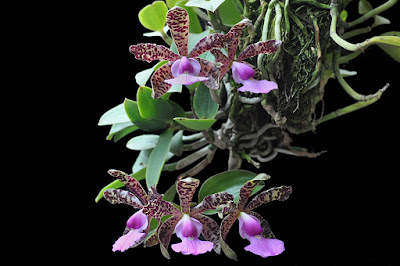Cattleya aclandiae is native to Brazil, state of Bahia. These plants meet on the coastal plains, and even up to 100 km inland, at altitudes from the sea level up to 400 m. A relatively small area of occurrence starts from south-western El Salvador and stretches north-east...
Cattleya aclandiae also called as Lady Ackland's Cattleya, Cattleya aclandiae f. alba, Cattleya aclandiae var. alba, Cattleya aclandiae var. grandiflora, Cattleya aclandiae var. salmonea, Cattleya aucklandiae, Cattleya auclandii, Epidendrum acklandiae, Epidendrum aclandiae, is a species of the genus Cattleya. This species was described by John Lindley in 1840.
IDENTIFY CATTLEYA ACLANDIAE
Cattleya aclandiae is native to Brazil, state of Bahia. These plants meet on the coastal plains, and even up to 100 km inland, at altitudes from the sea level up to 400 m. A relatively small area of occurrence starts from south-western El Salvador and stretches north-east. The highest density occurs on an erected plateau bordering the valleys of the Paraguacu river basin. They grows usually 3-6 m above the ground, in trees with very uneven bark. Plants grow on simple trunks and branch forks, in areas where water is always present. Unfortunately, it is difficult to find them in nature, due to over-harvesting or destruction of natural habitats for agricultural purposes.
It is a dwarf sized, warm growing epiphytic species, which reaching a height of 7-12 cm, with slender, jointed, furrowed, a height of 7-12 cm pseudobulbs carrying 2 apical, spreading, elliptic, thick, fleshy, red spotted, obtuse, 5-8 cm long leaves.
Lady Ackland's Cattleya blooms in the summer and fall on a short, terminal, inflorescence held within the developing leaves that carries 1 to 2, large in proportion to the plant, fragrant, waxy, long-lasting flowers. The flowers are 7-10 cm in diameter. The flakes of both whorls are green or yellowish with a variable number of dark red-brown, dark-purple or almost black spots. In the case of plants grown in very light conditions, an additional reddish color may appear. The ridge has small, white-bounded side plots that wrap up, but do not cover the spine. The large, flat center can have any shade from magenta to dark purple and darker venation. A wide exposed rod, lying very close to the lip, may be dark-purple or dark-crimson. The pollen chamber cover is in a contrasting, yellow color.
CATTLEYA ACLANDIAE CARE AND CULTURE
Cultural information should only be used as a guide, and should be to be adapted to suit you. Your physical location; where you grow your plants, how much time you have to devote to their care, and many other factors, will need to be taken into account. Only then can you decide on the cultural methods that best suit you and your plants.
Light:
Cattleya aclandiae needs a light level of 40000-45000 lux. The light should be kept as high as possible, so as not to burn the leaves. In most areas, the plants should be placed close to the windows to provide maximum light. Ensure a strong air movement not only to prevent tissue damage in very bright light, but also to allow the plant to dry out as quickly as possible after waterings.
It recommends a very high light level and 70% of the full sun is an ideal level. If the plants were grown earlier in more shadowy conditions, the level of light should be increased gradually. A sudden change can lead to very serious damage to the plant or even to the total destruction of the sun.
Temperature:
It is a thermophilic plant. The average summer temperature in the summer is 28-29 ° C, and the average night temperature is 22 ° C, with a daily amplitude of 6-7 ° C. The average temperature of the day in winter is 25-26 ° C, and the average night is 19-20 ° C, with a daily amplitude of 5-6 ° C.
Humidity:
Lady Ackland's Cattleya needs the humidity of 80-85% for most of the year, and falling to 75-80% in summer.
Substrate, growing media and repotting:
Cattleya aclandiae are usually attached to pieces of cork or placed in baskets, but also growing in pots with very loose, quickly drying substrate, such as thick bark pieces. Whatever the choice of substrate is, it is critical to quickly dry the roots after watering, otherwise you can be sure that the roots will rot.
This species should always be grown epiphytically and recommends using small pads, because larger ones can hold excess water too long. The tree fern holders retain more water, so they can only be used in very dry areas. To enable quick drying, do not install sphagnum moss pillows under the plants. This moss placement between the rootstock and the plant is usually recommended when fixing plants, but not for this species.
Repotting or dividing the plants should be done when the growth of new roots begins. This allows the plants to acclimatize in a relatively short time and provides them with the least stress.
Watering:
Cattleya aclandiae should be watered regularly throughout the year. They need to dry quickly after watering, but they can not be dry for a longer period. You can provides its plants with daily sprinkling and thorough immersement of the whole plant with a rootstock in the summer, twice a week in summer, and even 3 times a week in extremely hot weather. It only waters on clear mornings and pays attention to ensuring that the plant is dry before the evening.
Fertilizer:
The plants should be fertilized every week 1/4-1/2 of the recommended dose of fertilizer for orchids. A fertilizer with a high nitrogen content is beneficial from spring to mid-summer, and a fertilizer richer in phosphorus should be used in late summer and autumn.
Rest period:
In winter, watering should be slightly reduced, but the Cattleya aclandiae should never be completely dried or stay dry for a longer period. Fertilization should be reduced until spring, when the amount of water increases when watering.















COMMENTS